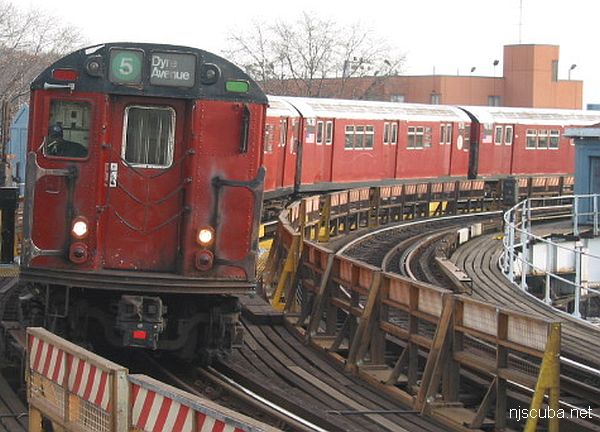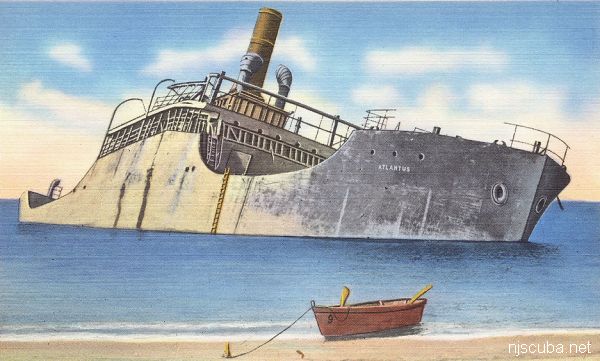Brightliner Subway Cars (3/3)
What was hoped-for:
New Jersey Department of Environmental Protection
Division of Fish and Wildlife
Marine Fisheries Administration
Stainless Steel Subway Cars Q&A
Benefits
What are the benefits of establishing artificial reefs in New Jersey's marine waters?
Reefs enhance our marine ecosystem by providing spawning, nursery, refuge, and feeding area for more than 150 species of fish and marine life. Deployed hard substrate materials such as rock, steel, and concrete provide an attachment medium for larval encrusting organisms to grow and mature. Encrusting organisms such as hydroids, anemones, barnacles, and blue mussels envelope the reef structure and form a thick living reef matrix. A myriad of minute crustaceans such as amphipods and isopods, in turn, take up housing in this protective environment and form an important component of the reef food chain. Reef-associated fishes such as black sea bass, tautog, and cunner utilize reefs as a food source and refuge.
Reefs also provide new fishing grounds for anglers and underwater areas to explore for scuba divers. Artificial reefs are especially important to the marine waters of New Jersey as the seafloor is characterized as sand or sand-mud plain interrupted by sand ridges and swales. The larvae of the encrusting organisms cannot attach to these sand grains and quickly wash away or become covered with sediments.
Is the marine environment being negatively changed by establishing artificial reefs?
The intent of New Jersey's Reef Program is not to change the marine environment, but rather to enhance a small portion of the seafloor to benefit about 150 species of fish and marine life. The benefited species are endemic but are limited in abundance by the lack of hard-substrate habitat. New Jersey's reefs are only artificial in that hard-substrate structures were intentionally placed in the marine environment. Everything that occurs after that is a natural process leading to the formation of an encrusting community of organisms. New Jersey's Reefs only occupy 0.3 percent of the ocean bottom out to 30 nautical miles.
Productivity
How productive will the subway cars be as reef material?
Studies performed by the New Jersey's Department of Environmental Protection's Division of Fish and Wildlife (DFW), Delaware Division of Fish and Wildlife, and South Carolina Division of Natural Resources show that subway cars develop into fully functional artificial reef habitat providing trophic support for reef fishes by supporting invertebrate communities.
How soon will fish utilize the subway cars as habitat?
Reef-associated fishes such as black sea bass and tautog are inherently structure-oriented. Although these fishes will be found in the immediate vicinity of the subway cars after the deployment, utilization will be the highest following two years of soak time when the reef matrix is fully developed. A three-year study conducted by the DFW found that the mean number of fishes found utilizing subway cars as habitat to be 323 per subway car after two years soak time. If this value were extrapolated to 600 subway cars, an expected 193,000 fishes would be found utilizing the subway cars as habitat.
Besides fish, what other types of marine life will utilize the subway cars as habitat? Marine invertebrates such as hydroids, anemones, barnacles, blue mussels, worms, and stony corals will colonize the subway cars. In addition to these invertebrates, crustaceans such as lobsters, shrimp, and stone crabs will use the reef matrix for refuge and a food source.
Durability
How long will the stainless steel subway cars last in the marine environment?
In 1990, the DFW performed a pilot study to determine the effectiveness and durability of subway car bodies as reef material. Five PATH ( Port Authority Transit Hudson ) subway cars were obtained from Southeastern Pennsylvania Transit Authority (SEPTA) for this purpose. Thirteen years following the deployment, surveys found the PATH subway cars to be upright and 67 percent intact. Newer subway cars are constructed of type 301 and 302 stainless steel, which is more resistant to marine corrosion than the carbon steel that the PATH and Redbird subway cars were constructed. The US EPA has estimated that the life span of the stainless steel cars to be between 25 - 35 years. This range is comparable to other reef material routinely deployed by New Jersey's Reef Program. The estimated life spans of the PATH and Redbird and subway cars deployed in 1990 and 2004 is 15-25 years.
Stability
Do subway cars move on the seafloor after being deployed?
A four-year study conducted by DFW found that subway cars do not move once deployed. Immediately following the deployment of 250 Redbird subway cars in 2003, Hurricane Isabel hit the New Jersey coast. To verify that the Redbird subway cars had not moved, the DFW performed a side-scan-sonar survey. Results indicated that the deployed subway cars were in the same positions as they were when dropped. Additional monitoring performed during 2004 - 2007 also showed that the subway cars were in the same positions. Stainless steel subway cars are equivalent in weight to the Redbirds and weigh approximately 18 tons each.
Asbestos
What is asbestos?
Asbestos is the common name for several minerals found in some geological formations that can be found in many places including New Jersey. Asbestos fibers naturally occur in surface waters in areas with these minerals. These minerals have been processed into products such as insulators and fire retardants.
Would there be asbestos fibers released from the subway cars?
Asbestos is contained within some materials in the subway cars. However, the asbestos fibers are encapsulated or contained within epoxy material and would not be expected to be released into the water column. Epifauna would most certainly be expected to cover the surfaces of the subway cars. This "growth" would be expected to minimize any release of asbestos.
What if the fibers were released, would they do harm?
In the unlikely case where fibers are released, concentrations would be expected to be low and below levels causing potential harm to aquatic animals (e.g., fish). This is due to the fibers being in an "encapsulated" state and subsequent dilution from ocean currents. Only very high concentrations of asbestos are considered a risk to aquatic animals. The release of high concentrations of asbestos fibers into the water column from a gradual deterioration of the asbestos-containing materials is not expected. The federal Environmental Protection Agency (EPA) states in their Final Guidance document: "Undisturbed, non-friable (not easily crumbled) asbestos has been found to be relatively harmless."
If the fibers were released, would they get into the food chain?
Since levels would be low or not present in the water column, levels of asbestos in reef animals would also be expected to be low. Animals higher on the food chain (e.g., fish) would not be expected to have greater concentrations of asbestos compared to animals lower on the food chain.
How is asbestos typically dealt with in reef materials?
The EPA recommends removing or encapsulating asbestos material that is exposed, disturbed, and deteriorated on materials destined for artificial reefs. Encapsulation with epoxy or other non-water soluble and non-toxic sealer is recommended.
What about the asbestos on the subway cars?
The remaining asbestos material on the subway cars is encapsulated ( e.g., epoxy interior car coating ) and is not considered friable. The danger of asbestos with these (non-friable) types of materials appears to be from grinding, sanding, or cutting ( i.e., resulting in the release of fibers ). This type of activity is not expected prior to or subsequent to deployment on the reefs.
Other
How much will it cost for New Jersey to deploy subway cars as artificial reefs?
All past and future subway cars received by New Jersey are free of any cost.
South and Mid-Atlantic Reef Perspectives
For everything you ever wanted to know about New York City subways, go to nycsubway.org.


